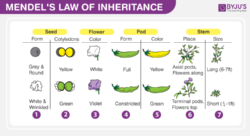According to the CBSE Syllabus 2023-24, this chapter has been renumbered as Chapter 4.
Heredity is a process of transferring traits/characteristics from parents to their offspring, which can be carried out either through the sexual or asexual mode of reproduction. These characteristics or traits are located in the form of genes on the chromosomes. Genes carry instructions which can have a similarity to one of their two parents.
Students can refer to the short notes and MCQ questions along with separate solution pdf of this chapter for quick revision from the links below:
- Principles of Inheritance and Variation Study Notes
- Principles of Inheritance and Variation MCQ Practice Questions
- Principles of Inheritance and Variation MCQ Practice Solutions
Gregor Johann Mendel, usually referred to as the Father of Genetics, was the first person to conduct experiments on Inheritance, Genetics, Heredity and Variations.

Read more: Important Questions for Class 12 Chapter 5 Principles of Inheritance and Variations
Law of Inheritance or Mendel’s Laws of Inheritance
Inheritance is a phenomenon through which traits are transferred from the parent to its progeny and form the base of heredity. Variation, on the other hand, is the extent/level to which the progeny differs from their parents and usually occurs due to the reshuffling of a gene or chromosomes, mutations, crossing over and other environmental effects.
According to Mendel’s experiments on Pisum sativum(garden pea) plants for seven years:

Plant Height
| Parental | TALL | DWARF | ||
| F1 Generation | TALL | TALL | ||
| F2 Generation | TALL | TALL | TALL | DWARF |
In his experiments, he crossed both the tall and dwarf pea plants in order to study the inheritance of one gene. He noticed that all the F1 progeny plants were tall, as one of its parents, and none of them was dwarf. Mendel notes similarity for the other pairs of traits and observed that the F1 in all instances resembled either one of the parents and also, the other parents’ trait was not observed in them.
Then, Mendel self-pollinated the F1 tall plants and was surprised to find that in the F2 generation, few of the offspring were dwarf, the trait that was not observed in the F1 generation was expressed now. According to his observations, the ratio of plants that were dwarf was 1:4 of the F2 plants, while the ratio of F2 plants that were tall was found to be 3:4. The dwarf and tall traits were identical to their parental type.
See Also: Mendelian Genetics
For more information on Law of Segregation, watch the below video

Mendel proposed two general rules on the basis of his observations on monohybrid crosses which came to be known as the Principles of Laws of Inheritance.
I. Law of Dominance(First Law)
- Factors are the discrete units controlling characters.
- These occur in pairs.
- In a dissimilar pair of factors, one pair of the member is dominant while the other is recessive.
II. Law of Segregation(Second Law)
Alleles do not exhibit any blending, both traits are recovered in the F2 generation, and one of these is, although not observed at the F1 stage. During gamete formation, though parents possess two alleles, they split from each other in a way that a gamete obtains only one of the two factors.
Laws of Independent Assortment
Mendel proposed another set of general rules basis his observations on dihybrid crosses which came to be known as Mendel’s Law of Independent Assortment which states “when two pairs of traits are combined in a hybrid, segregation of one pair of characters is independent of the other pair of characters”. This can be effectively understood with the help of a Punnett square carried out with two pairs of genes during the stage of meiosis and egg production and pollen in the F1 generation of the RrYy plant.
Linkage and Assortment
- Morgan coined the ‘linkage’ term to brief about the physical association of genes on a chromosome or the linkage of two genes and the ‘recombination’ term to explain the generation of non-parental gene combinations.
Mutation
- It results in the alteration of DNA sequences resulting in changes in the phenotype and genotype of an entity. Along with recombination, mutation also leads to variations in DNA.
- Chromosomal alteration causes aberrations or abnormalities. Typically, these aberrations are observed in cancer cells.
- Point mutation – takes place as a result of changes in single base pair of DN. Example- sickle cell anaemia while insertions and deletions of base pairs of DNA lead to frame-shift mutations.
Mendelian Disorders
Some of the Mendelian disorders are:
- Cystic fibrosis
- Haemophilia
- Sickle-cell anaemia
- Phenylketonuria
- Colour blindness
- Thalassemia
Few Important Questions
- What is point mutation? Give one example
- Define Principles of Inheritance and Variation.
- Differentiate between Homozygous and Heterozygous.
- List out the three main laws proposed by Gregor Johann Mendel.
Learn more about Heredity, the Law of Inheritance, chromosomes, and genes from the topics given below:
| Chromosomes | Principles of Genetics |
| Mendel’s Laws of Inheritance | Chromosomal Theory of Inheritance |
Frequently Asked Questions on CBSE Class 12 Biology Notes Chapter 5 Principles of Inheritance and Variation
What is the theory behind Mendeleev’s Law of Inheritance?
The key principles of Mendelian inheritance are summed up by Mendel’s three laws: the Law of Independent Assortment, the Law of Dominance, and the Law of Segregation.
What is meant by F1 and F2 generation?
F1: It is the first filial generation obtained by crossing two different parents. F2: It is the second filial generation obtained by self-crossing the F1 generation.
What is thalassemia?
Thalassemia is an inherited blood disorder that causes your body to have less haemoglobin than normal.
Comments